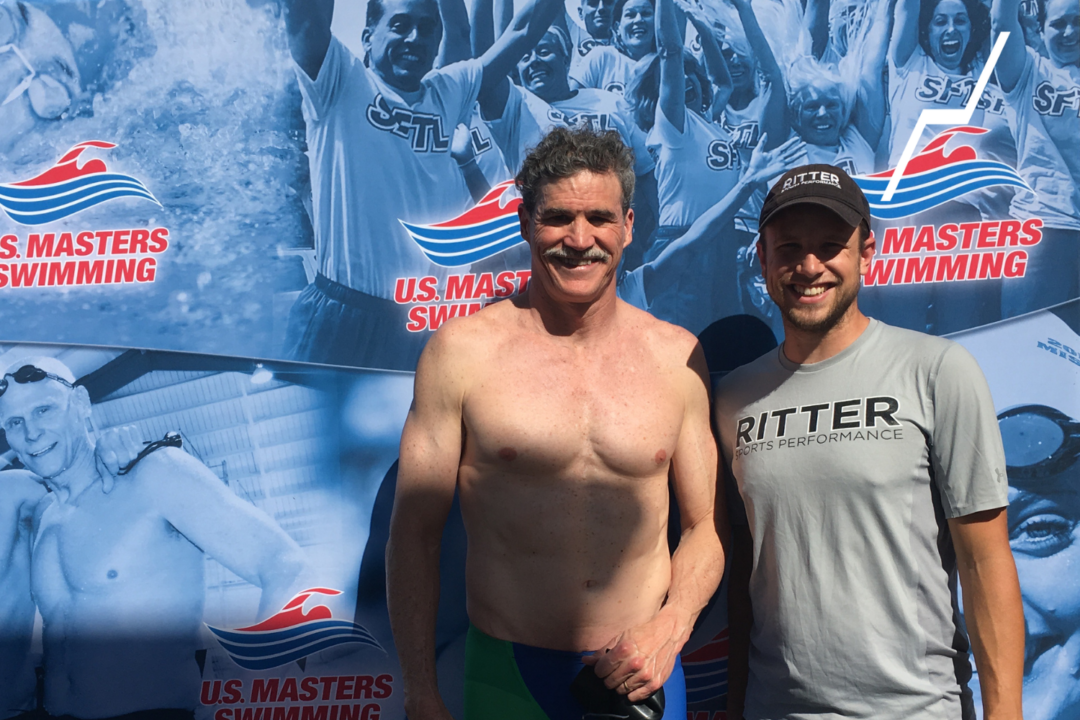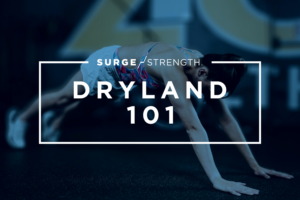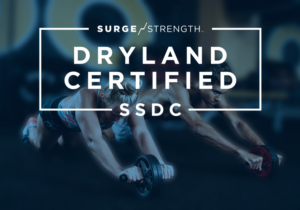Dryland workouts for masters swimmers are just as important as swim practices for masters swimmers. As we get older, life happens. People have jobs, families, and responsibilities. These factors limit the time swimmers can commit to training. Aging also brings on physical barriers to staying in shape. For instance, injuries crop up significantly more easily, and energy levels naturally change. Physiological fluctuations cause people to be more selective about how they spend their training time. Therefore, it’s easier for masters’ athletes to keep their eyes fixed on the pool. However, research shows that dryland is extremely important for adults, especially masters swimmers ages 40 and up. SURGE Strength provides resistance training through comprehensive dryland plans in order to fit the needs of this population. Below, we discuss how to tailor dryland for Masters swimmers and why progressive resistance training is an irreplaceable activity:
Age Considerations for Masters Swimmers Doing Dryland Workouts
Our bodies change as we age. By the time we hit 40, strength and power naturally start to decrease. This is because our fast-twitch muscle fibers start to diminish through a process called apoptosis. Apoptosis is morbidly known as programmed cell death. It is our body’s natural design of aging. Luckily, the best way to slow the aging process for our fast-twitch fibers is through resistance training. We can train our muscles to grow faster than the aging process breaks them down through a concept known as progressive overload. Not only are our masters swimmers stronger in the pool, but they also accomplish activities in their daily life with more ease than people who do not incorporate resistance training.
- Fast-twitch muscle fibers: otherwise known as type II muscle fibers are the large fibers that help us move quickly and explosively through short bouts of intense exercise. For example: jumping off the block, or sprinting a 50 freestyle uses predominantly fast-twitch muscle fibers.
- Progressive Overload: consistently training to fatigue at a rate we can recover and become more fit.
Osteoporosis Prevention through Dryland Workouts for Masters Swimmers
Another huge benefit of resistance training is building strong bones. According to the National Osteoporosis Foundation, 50% of people over age 50 are at a higher risk of breaking a bone due to low bone density. As much as we would like to say swimming helps lower your risk for osteoporosis, it, unfortunately, does not. This is because the bones need impact to break down and rebuild stronger. To accommodate for the anti-gravity effect of swimming, we can build the bones through weight-bearing activity in dryland. Weight training 1-2 times per week significantly reduces the risk of developing osteoporosis. It also slows down and reverses osteopenia, the beginning stages of osteoporosis.
Other Benefits of Resistance Training in Dryland Workouts for Masters Swimmers
There are many other short- and long-term benefits to resistance training. In the SURGE Strength Dryland Certification Curriculum, we teach swimmers and coaches how to implement exercise progressions specifically to improve mobility, stability, coordination, and balance. These are all benefits associated with dryland in addition to increasing strength, power, and endurance. All these variables improve athleticism for swimming. More importantly, they help us move into age, and accomplish activities of daily life that become challenging over time for our sedentary friends.
Other benefits of resistance training include improved cholesterol, decreased blood pressure, improved body composition, and better blood circulation. People who resistance train also have a lower risk of falling due to increased balance and stability. Overall swimmers who participate in dryland will have a better performance in the pool as well as a better quality of life at home.
FITT Goals for Dryland Workouts for Masters Swimmers
Setting “FITT” goals allow us to define our dryland expectations. FIIT stands for frequency, intensity, time, and type. These parameters give us a road map of how to set up a progressive dryland program for our individual needs. An individual’s goals determine how we write their dryland plan. As we age, our goals for swimming vary more and more. For instance, a 30-year-old typically has very different goals than a 70-year-old. Our commitment to swimming, as well as our physical ability in the sport also changes. For example, a 70-year-old who has been lifting weights for years and winning championships has different goals than a 70-year old who has never done dryland before and just wants to keep up with their grandkids.
We break these FITT goals down below:
1) Frequency of Dryland Workouts for Masters Swimmers
Exercise frequency refers to how often the swimmer trains. The SURGE Strength Dryland Certification Curriculum recommends aiming for 2-3 dryland sessions per week. We have found that keeping dryland sessions and swim practice close together is an effective way to train masters swimmers ages 40 and up. For example, swim in the morning. Take a short break to eat and recover. Then, head to dryland in the afternoon. We then recommend recovering for at least 24-48 hours before training again. It is important to keep in mind that swim volume and intensity should be decreased on days where athletes are both swimming and lifting.
We have also found it effective to evenly space out swim practice and dryland with a 24-hour rest period in-between sessions. In most cases, the individual swims 3-5 times per week and alternates in 2 dryland sessions per week. Swim intensity and volume will be lower on days following dryland.
For masters athletes in the 40-60-year-old range, less is more. We encourage these athletes to prioritize rest and let their bodies fully recover. This way, they are less likely to overtrain or get injured. Masters swimmers who spread out their dryland to just a couple of times per week have proven to have better longevity in the sport.
2) Intensity of Dryland Workouts for Masters Swimmers
Masters swimmers can still complete challenging dryland workouts. In fact, many older athletes still crave hard training. Defining the intensity of a dryland workout is very subjective because everyone has a unique capability. Therefore, the perceived rate of exertion can be used as a guide for intensity if athletes are healthy. The key to maintaining challenging dryland workouts is providing adequate rest periods. Masters athletes will need a full recovery ranging from 1 minute all the way up to 5 full minutes between exercises or sets, depending on the intensity of the exercise.
In addition to longer rest periods, coaches should also consider the volume of dryland training they are programming. Intensity and volume are inversely related in this instance. This means that as intensity goes up, the volume goes down. Since rest is increased, it makes sense to cut back reps or sets anyway in order to finish the workout in a reasonable amount of time.
Another factor related to intensity is exercise progression. It takes longer to develop exercise progressions as we age. It also takes longer to work up to the desired reps and sets with quality form. Even an athlete who has plenty of resistance training experience and muscle memory will take longer to master a new movement than a swimmer in their 20’s. This is because it takes longer for the body to develop new neuromuscular pathways with age.
Overall, exercise intensity should be monitored throughout the session. It can also be gauged by how sore or tired the athlete feels after their dryland workout. It is okay to challenge exercise intensity if other factors such as volume and exercise complexity are adjusted in turn.
3) Time for Dryland Workouts for Masters Swimmers
As swimmers age, their energy capacity also decreases. We recommend keeping dryland sessions to an hour or less. Our goal is not to train Olympic weightlifters. It is instead to supplement swimming with the benefits of resistance training. When training efficiently, an hour of dryland 2-3 times per week is plenty of time to accomplish these goals.
4) Type of Dryland Workouts for Masters Swimmers
As we’ve talked about, resistance training improves mobility, stability, balance, coordination, strength, power, and endurance. Therefore, we recommend the implementation of exercises that focus on training these variables. Simple movements such as squats, hinges, push-ups, planks, and pull-ups are sometimes the most effective. Incorporating a few complex exercises may also be a fun challenge for masters swimmers. Most importantly, the swimmer should enjoy the exercises in the program and feel safe doing them.
- Learn more about our top recommended training movements: The 5 Movements Every Dryland Program Should Have
When creating a dryland plan with masters athletes in mind, we recommend weighing the risks and benefits of each exercise involved. Know the reason for selecting each exercise in your dryland program. Choose exercises that maximize the benefits of resistance training. Then, step back and look at the bigger picture. Does your dryland plan match the goals of the athlete in terms of frequency, intensity, time, and exercise selection? Use these variables to constantly reassess your dryland program. This way, you know you are in the “sweet spot” for intensity, volume, and recovery. By using FIIT goals and understanding the importance of resistance training, you can create a dryland program to serve masters athletes of all ages.
MORE DRYLAND RESOURCES FROM SURGE STRENGTH:
ENROLL IN A DRYLAND 101 COURSE FOR FREE
GET STARTED WITH A DRYLAND PROGRAM
LEARN ABOUT BECOMING SSDC

SURGE Strength’s Mission:
BUILD BETTER ATHLETES
GENERATE FASTER SWIMMERS
Courtesy of SwimSwam’s exclusive dryland training partner, SURGE Strength.
SURGE Strength, a strength training brand created by Chris Ritter, CEO of RITTER Sports Performance, aims to build better athletes and faster swimmers through dryland programs and educational courses.
Get started with a SURGE Strength Dryland Program or enroll in a dryland course in the SURGE Strength Academy today!










